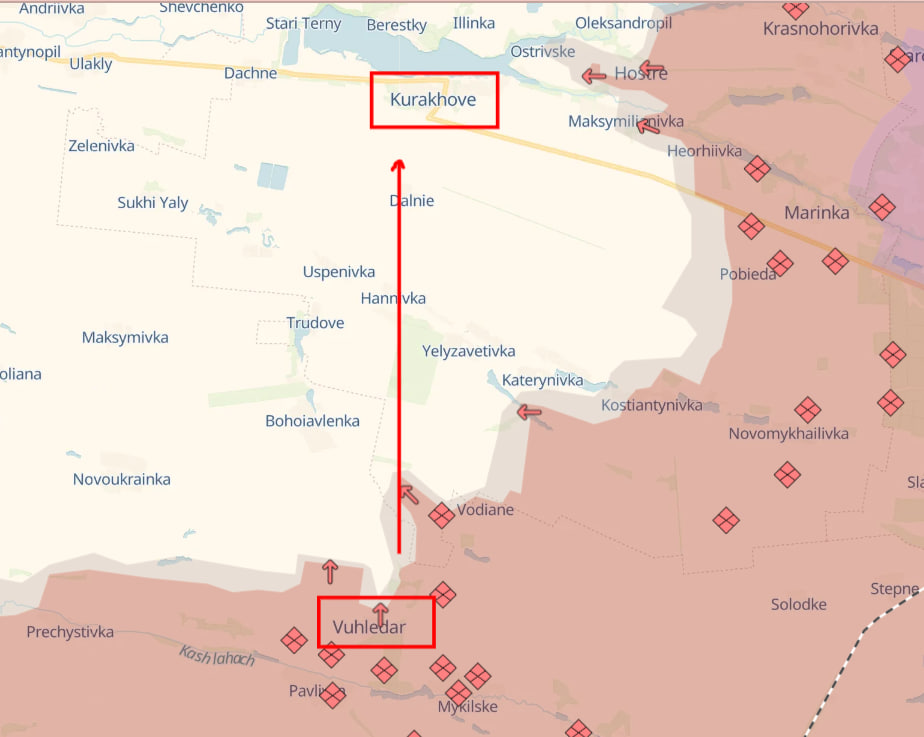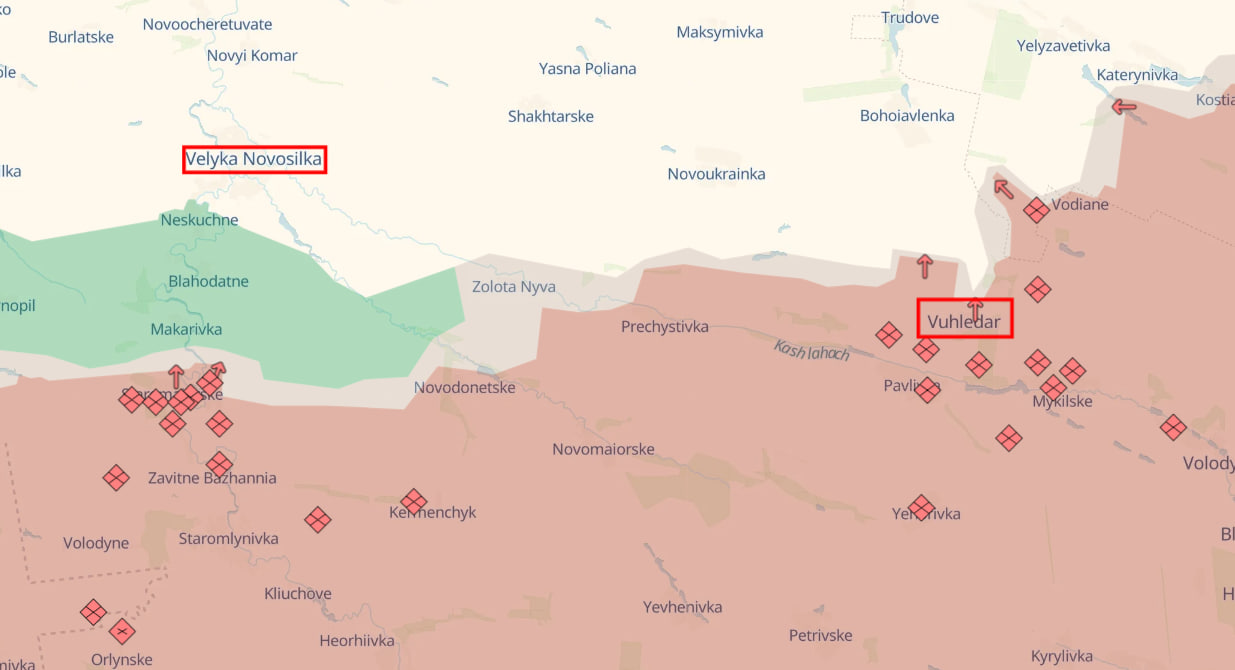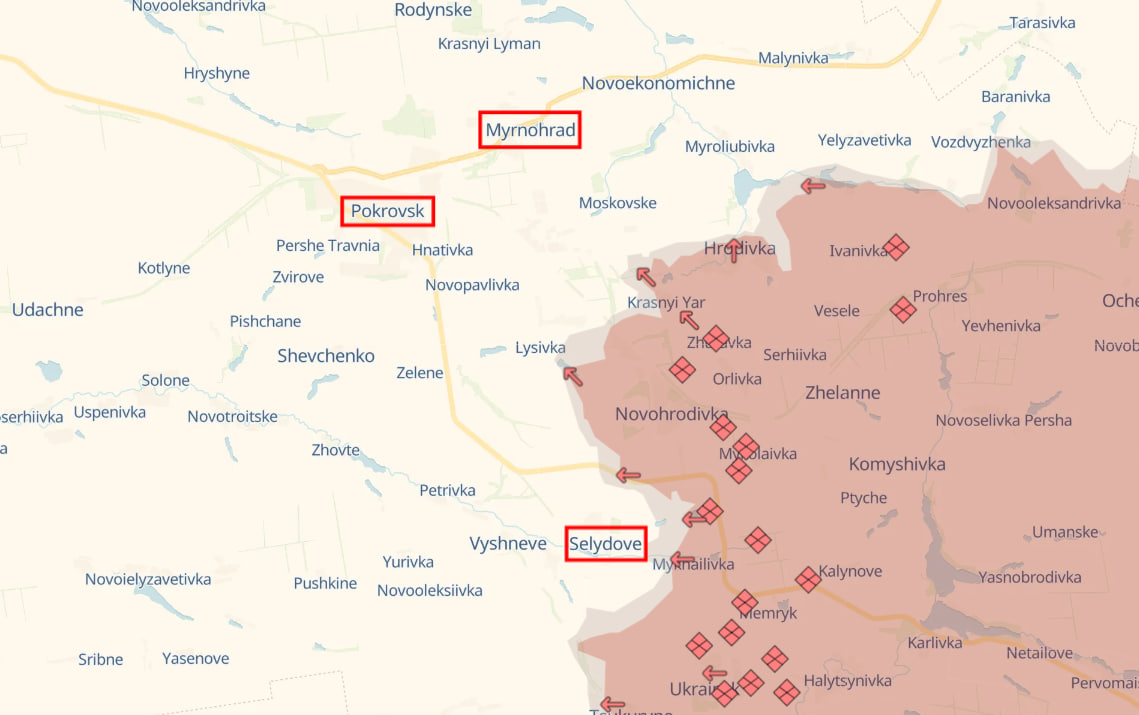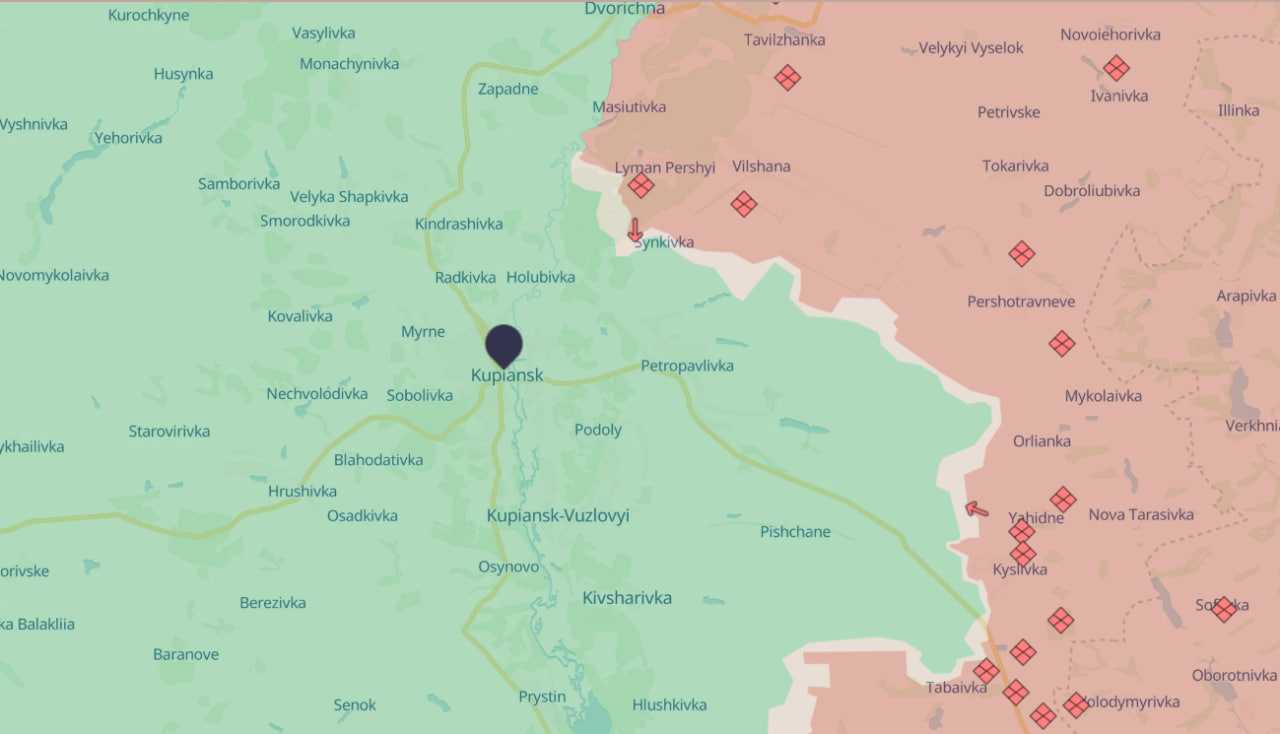No front collapse: Impact of Ukraine’s withdrawal from Vuhledar and cities now at risk
 Ukrainian troops repel intense Russian attacks, no operational pause is expected until January (photo by Getty Images)
Ukrainian troops repel intense Russian attacks, no operational pause is expected until January (photo by Getty Images)
Russian forces in the Donetsk region have not stopped capturing Vuhledar and continue to push on other sections of the front. Kurakhove and Pokrovsk are the primary targets, but the enemy is not abandoning secondary directions either. What to expect on the front and which cities are next under threat is detailed in the RBC-Ukraine coverage.
Contents
- Vuhledar has been lost, but the front hasn’t collapsed
- Where Russians might move next
- Kurakhove and Pokrovsk as main objectives
- Are there threats on other fronts?
Vuhledar has been lost, but the front hasn’t collapsed
Russian forces reached Vuhledar early in the full-scale invasion of 2022. However, the "damned fortress," as enemy propaganda dubbed it, didn’t fall easily, though it was long on the brink. Strategic positions allowed Ukraine’s defense forces to hold their ground and deal significant blows to the enemy.
One of the most devastating defeats for Putin’s forces occurred near Vuhledar. In February 2023, the 155th Separate Guards Marine Brigade – an elite unit of the Pacific Fleet – was heavily hit. After that, large-scale assaults ceased until the Russians began relying on air bombs.
This changed the situation, and by August, the occupiers were advancing from the flanks. Within weeks, they captured territory west and east of Vuhledar, and by the end of September, the city was nearly encircled. Ukrainian forces were left with one road to the north, and the gap between Russian pincers had narrowed to just two kilometers.
On October 1, DeepState reported the occupation of Vuhledar. Russian social media circulated photos and videos of Russian flags all over the city. The official withdrawal of Ukrainian forces was confirmed the next day.

deepstatemap.live
The Khortytsia operational-strategic group said that flanking strikes had exhausted Ukraine’s defenses, creating a risk of encirclement. “High command authorized a maneuver to withdraw forces from Vuhledar to preserve personnel and equipment,” said the military.
Vuhledar was a valuable platform for disrupting railway logistics through Volnovakha (connecting the southern parts of the Donetsk and Zaporizhzhia regions). Its loss is a significant blow but does not provide a strategic breakthrough for the Russians.
According to Oleksandr Musiienko, head of the Center for Military-Legal Research, the withdrawal was well-coordinated, despite facing superior enemy forces.
"The front hasn’t collapsed, and I don’t think it will. The only thing to keep in mind is that if the enemy maintains this pressure, we may need to fall back closer to Kurakhove to hold new positions and try to halt Russia’s advance. Kurakhove will be a strong defensive redoubt. The situation is under control, and it can’t be said that with the capture of Vuhledar, the enemy has gained a strategic advantage to rapidly accelerate their offensive," he told RBC-Ukraine.
Unfortunately, there’s no indication that the Russians are ready to slow down, and the next strike could come on this or several other fronts simultaneously.
Where Russians might move next
The capture of Vuhledar doesn’t give the occupying forces any decisive advantage, agrees military-political analyst Oleksandr Kovalenko from the Information Resistance group.
According to him, the main objectives for Russia by the end of the year include capturing Kurakhove, Pokrovsk, Toretsk, and Chasiv Yar, alongside secondary goals such as eliminating the Robotyne salient, advancing along the Orikhiv axis, intensifying pressure towards Huliaipole and the Vremivka direction, reaching the left bank of the Oskil River, and cutting off the Lyman-Kupiansk axis.
However, Russia lacks the forces and resources to achieve both primary and secondary goals, as well as confidence in maintaining an advantage in 2025, as evidenced by Putin’s decrees to increase army size, the expert adds.
British intelligence also says that Vuhledar sits at the intersection of the key Donetsk and Zaporizhzhia fronts. It predicts an offensive westward towards Velyka Novosilka (heading for Zaporizhzhia along the T0509 highway) and northward towards the village of Bohoyavlenka.

deepstatemap.live
Kovalenko suggests that after Vuhledar, the Russians will try to advance towards Bohoyavlenka and Novoukrainka. However, this will be a “stage of long-term field battles.” Musiienko sees the key objective on this front as the city of Kurakhove – to encircle and isolate it.
Regarding Velyka Novosilka, it’s worth recalling that less than a year ago, when the enemy advanced after capturing Maryinka, it seemed that they could push toward Kurakhove without threatening Vuhledar.
"But they didn’t bypass Vuhledar. So, I think if they advance on Velyka Novosilka, it will be to divert our forces, but the focus will remain on enveloping operations around Kurakhove," he explained to RBC-Ukraine.
In the northern part of Donetsk, battles for Toretsk are happening under more challenging conditions for Russia compared to the early stages of the agglomeration offensive. Currently, Ukrainian forces are operating from industrial zones, and the terrain and other obstacles are also working against Russian advances. Toretsk, like Vuhledar and Avdiivka before it, is draining Russia’s offensive resources.
Another sensitive point is Chasiv Yar, where an assault has been ongoing since October 2023. So far, the occupiers haven’t crossed the Siverskyi Donets–Donbas canal and are losing up to a company per day, Kovalenko says.
Kurakhove and Pokrovsk as main objectives
According to reports from Ukraine’s General Staff, the Kurakhove and Pokrovsk fronts remain the hottest spots. Several dozen clashes are recorded there daily, indicating that Kurakhove and Pokrovsk are under significant threat.
"These are the two main points where the Russians are concentrating their offensive activity. The goal is clear: to conduct flanking operations to encircle them and create the prospect of operational encirclement," says Musiienko.

deepstatemap.live
The enemy will likely attack Kurakhove from the south (from Vuhledar) and the east (from Maryinka). The north is blocked by natural obstacles. "This doesn’t mean they will enter Kurakhove. The main goal is to create the threat of encirclement and apply pressure from the south and east," he said.
In Pokrovsk, an enveloping operation has been in progress for some time. The occupiers are trying to push north through Myrnohrad and are advancing south toward Selydove.
"Why are they doing this? Because, according to Russian command, even if they can’t enter these cities directly, they aim to surround them and exert pressure from the flanks. That’s what happened in Avdiivka, which was in a large semi-encirclement before Russia gathered enough forces to enter the town," Musiienko added.
Kovalenko believes the Russian army wants quick victories, but the southern flank is not yet prepared for an assault on Pokrovsk. Additionally, the city of Selydove has become a “thorn in the side,” and the battles for it will be as grueling for the enemy as those for Vuhledar.
Are there threats on other fronts?
Last week, Southern Defense Forces spokesperson Vladyslav Voloshyn mentioned the possibility of renewed, more focused assaults in the Zaporizhzhia region. According to intelligence reports, the enemy is redeploying personnel and preparing to advance near Orikhiv and Robotyne.
If they manage to break through, they would gain fire control over the logistics routes from Zaporizhzhia to the southern parts of the Zaporizhzhia and Donetsk regions.
Threats in the Zaporizhzhia direction are indeed real, according to Oleksandr Musiienko. He believes this situation has emerged due to the Russians accumulating forces and preparing to resume offensive operations after previously redeploying some units to the Kursk region.
"Now that reinforcements have arrived, they will likely step up operations here too. However, the goal isn't so much to capture large territories but to stretch our lines and divert attention from key areas of attack in the Donetsk region," the expert said.

deepstatemap.live
The Kupiansk direction poses significantly greater threats, especially considering the enemy continues attacking positions near this district center in the Kharkiv region, while slightly further south, they are attempting to advance to the eastern bank of the Oskil River, aiming to split the Ukrainian stronghold.
For instance, last week, the number of attacks in this area reached 22 per day, surpassing those near Pokrovsk. The defense forces repelled assaults near Synkivka, Novoselivka, Pishchane, Stelmakhivka, and Lozova.
Kupiansk Military Administration Head Andrii Besiedin emphasizes that the city is being hit by guided aviation bombs, which destroy everything within a kilometer radius. The left-bank part of the city is almost entirely wiped out, and critical and civilian infrastructure, including businesses, has been destroyed.
Musiienko predicts the enemy will continue operating in its usual manner. Regarding their attempts to break through to the Oskil River, large amounts of armored vehicles are being deployed here, a stark contrast to other frontline sectors.
"Our units are destroying these vehicles, but the Russians are still achieving some tactical successes. I believe they will try to advance as far as they are capable of, aiming to reach the river and threaten our grouping in Kupiansk. Additionally, they want to provoke our command into redeploying forces from the Kursk region to the Kharkiv region," he said.
***
According to various estimates, Russia has concentrated over 500,000 troops along the front line, several times more than at the start of the full-scale invasion. As a result, it is difficult to predict where the next major strike will occur.
Some suggest the enemy is at its peak, which may last a few more weeks until heavy rains arrive. However, this is probably the last factor to consider when it comes to fighting in the East. As experience has shown, weather conditions do not stop the Russians.
"Of course, they may reduce the intensity of combat operations. But before winter, Russia will still attempt to advance and achieve certain objectives. Until December, and possibly taking an operational pause around January," Musiienko said.
Judging by the situation on the front, the enemy will continue throwing infantry into numerous assaults, regardless of losses.
"I hope our forces are preparing for such a scenario. For now, Ukrainian troops are delivering containment strikes and conducting active defense. We are able to hold the line and repel attacks. The situation is difficult, and we may have to withdraw in certain areas. But there is no catastrophe," the expert concluded.
Sources: analysis and maps from the DeepState project, assessments from British intelligence, updates from the General Staff of the Armed Forces of Ukraine, a Telegram post by military-political analyst Oleksandr Kovalenko of the Information Resistance group, and comments from Oleksandr Musiienko, head of the Center for Military-Legal Studies.

